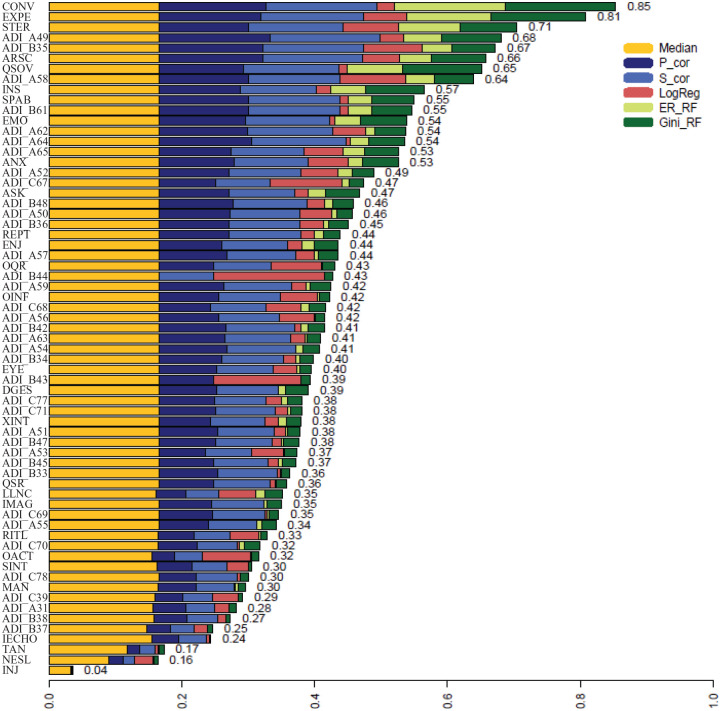Figure 4.
Results of ensemble feature selection.
Values report item importance with higher values indicating higher importance for classification. Median: p-values from Wilcoxon signed-rank test; P_cor: Pearson product-moment correlation; S_cor: Spearman rank correlation; LogReg: β-values of logistic regression; ER_RF: error-rate based on random Forest analysis; Gini_RF: Gini-index based on random Forest analysis; ANX: anxiety; ARSC: amount of reciprocal social communication; ASK: asks for information; CONV: conversation; DGES: descriptive, conventional, instrumental, or informational gestures; EMO: empathy/comments on other’s emotions; ENJ: shared enjoyment in interaction; EXPE: facial expressions directed to examiner; EYE: unusual eye contact; IECHO: immediate echolalia; IMAG: imagination/creativity; INJ: self-injurious behavior; INS: insight; LLNC: language production and linked nonverbal communication; MAN: hand and finger and other complex mannerisms; NESL: overall level of nonechoed language; OACT: overactivity; OINF: offers information; OQR: overall quality of rapport; QSOV: quality of social overtures; QSR: quality of social response; REPT: reporting of events; RITL: compulsions or rituals; SINT: unusual sensory interest in play material/person; SPAB: speech abnormalities associated with autism; STER: stereotyped/idiosyncratic use of words or phrases; TAN: tantrums, aggression, negative or disruptive behavior; XINT: excessive interest in or references to unusual or highly specific topics or objects or repetitive behaviors; ADI_A31: use of other’s body to communicate; ADI_A49: imaginative play with peers; ADI_A50: direct gaze; ADI_A51: social smiling; ADI_A52: showing and directing attention; ADI_A53: offering to share; ADI_A54: seeking to share enjoyment with others; ADI_A55: offering comfort; ADI_A56: quality of social overtures; ADI_A57: range of facial expressions used to communicate; ADI_A58: inappropriate facial expressions; ADI_A59: appropriateness of social response; ADI_A62: interest in children; ADI_A63: response to approaches of other children; ADI_A64: group play with peers; ADI_A65: friendships; ADI_B33: stereotyped utterances and delayed echolalia; ADI_B34: social verbalization/chat; ADI_B35: reciprocal conversation; ADI_B36: inappropriate questions of statements; ADI_B37: pronominal reversal; ADI_B38: neologism/idiosyncratic language; ADI_B42: pointing to express interest; ADI_B43: nodding; ADI_B44: head shaking; ADI_B45: conventional/instrumental gestures; ADI_B47: spontaneous imitation of actions; ADI_B48: imaginative play; ADI_B61: imitative social play; ADI_C39: verbal rituals; ADI_C67: unusual preoccupations; ADI_C68: circumscribed interests; ADI_C69: repetitive use of objects or interest in parts of objects; ADI_C70: compulsions/rituals; ADI_C71: unusual sensory interests; ADI_C77: hand and finger mannerisms; ADI_C78: other complex mannerisms or stereotyped body movements.

